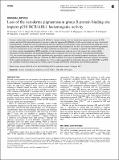| dc.contributor.author | Pannucci, N L | en_US |
| dc.contributor.author | Li, D | en_US |
| dc.contributor.author | Sahay, S | en_US |
| dc.contributor.author | Thomas, E K | en_US |
| dc.contributor.author | Chen, R | en_US |
| dc.contributor.author | Tala, I | en_US |
| dc.contributor.author | Hu, T | en_US |
| dc.contributor.author | Ciccarelli, B T | en_US |
| dc.contributor.author | Megjugorac, N J | en_US |
| dc.contributor.author | Adams III, H C | en_US |
| dc.contributor.author | Rodriguez, P L | en_US |
| dc.contributor.author | Fitzpatrick, E R | en_US |
| dc.contributor.author | Lagunoff, D | en_US |
| dc.contributor.author | Williams, D A | en_US |
| dc.contributor.author | Whitehead, I P | en_US |
| dc.date.accessioned | 2014-03-10T16:17:47Z | |
| dc.date.issued | 2013 | en_US |
| dc.identifier.citation | Pannucci, N. L., D. Li, S. Sahay, E. K. Thomas, R. Chen, I. Tala, T. Hu, et al. 2013. “Loss of the xeroderma pigmentosum group B protein binding site impairs p210 BCR/ABL1 leukemogenic activity.” Blood Cancer Journal 3 (8): e135. doi:10.1038/bcj.2013.36. http://dx.doi.org/10.1038/bcj.2013.36. | en |
| dc.identifier.issn | 2044-5385 | en |
| dc.identifier.uri | http://nrs.harvard.edu/urn-3:HUL.InstRepos:11877138 | |
| dc.description.abstract | Previous studies have demonstrated that p210 BCR/ABL1 interacts directly with the xeroderma pigmentosum group B (XPB) protein, and that XPB is phosphorylated on tyrosine in cells that express p210 BCR/ABL1. In the current study, we have constructed a p210 BCR/ABL1 mutant that can no longer bind to XPB. The mutant has normal kinase activity and interacts with GRB2, but can no longer phosphorylate XPB. Loss of XPB binding is associated with reduced expression of c-MYC and reduced transforming potential in ex-vivo clonogenicity assays, but does not affect nucleotide excision repair in lymphoid or myeloid cells. When examined in a bone marrow transplantation (BMT) model for chronic myelogenous leukemia, mice that express the mutant exhibit attenuated myeloproliferation and lymphoproliferation when compared with mice that express unmodified p210 BCR/ABL1. Thus, the mutant-transplanted mice show predominantly neutrophilic expansion and altered progenitor expansion, and have significantly extended lifespans. This was confirmed in a BMT model for B-cell acute lymphoblastic leukemia, wherein the majority of the mutant-transplanted mice remain disease free. These results suggest that the interaction between p210 BCR/ABL1 and XPB can contribute to disease progression by influencing the lineage commitment of lymphoid and myeloid progenitors. | en |
| dc.language.iso | en_US | en |
| dc.publisher | Nature Publishing Group | en |
| dc.relation.isversionof | doi:10.1038/bcj.2013.36 | en |
| dc.relation.hasversion | http://www.ncbi.nlm.nih.gov/pmc/articles/PMC3763389/pdf/ | en |
| dash.license | LAA | en_US |
| dc.subject | chronic myelogenous leukemia | en |
| dc.subject | p210 BCR/ABL1 | en |
| dc.subject | XPB | en |
| dc.subject | NER | en |
| dc.subject | DNA repair | en |
| dc.title | Loss of the xeroderma pigmentosum group B protein binding site impairs p210 BCR/ABL1 leukemogenic activity | en |
| dc.type | Journal Article | en_US |
| dc.description.version | Version of Record | en |
| dc.relation.journal | Blood Cancer Journal | en |
| dc.date.available | 2014-03-10T16:17:47Z | |
| dc.identifier.doi | 10.1038/bcj.2013.36 | * |
| dash.authorsordered | false | |


